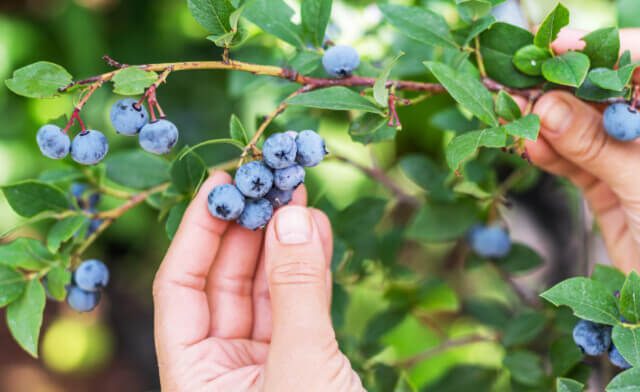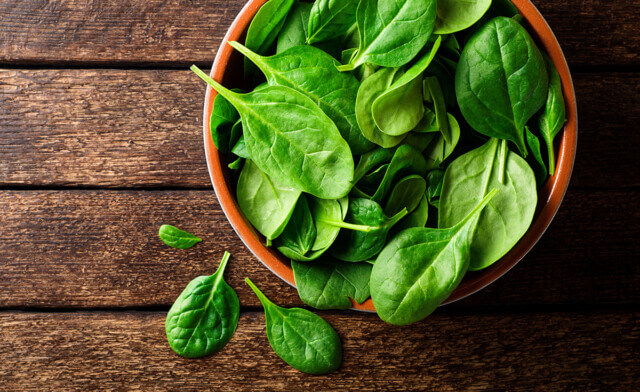Grain Free Weight Loss Dog Food: What Is it and How Can it Help Your Dog?
If you have an overweight dog, you may be on the hunt for a weight management dog food. With so many options on the market though, it can be hard to know what to look for. Learn more about the difference between grain-free and whole grain dog food, decide which is better suited for your furry family member. Even learn more about grain-free weight loss dog food such as our own Weight Control dry dog food recipe to see if it’s a good fit to help your dog lose a few extra pounds.
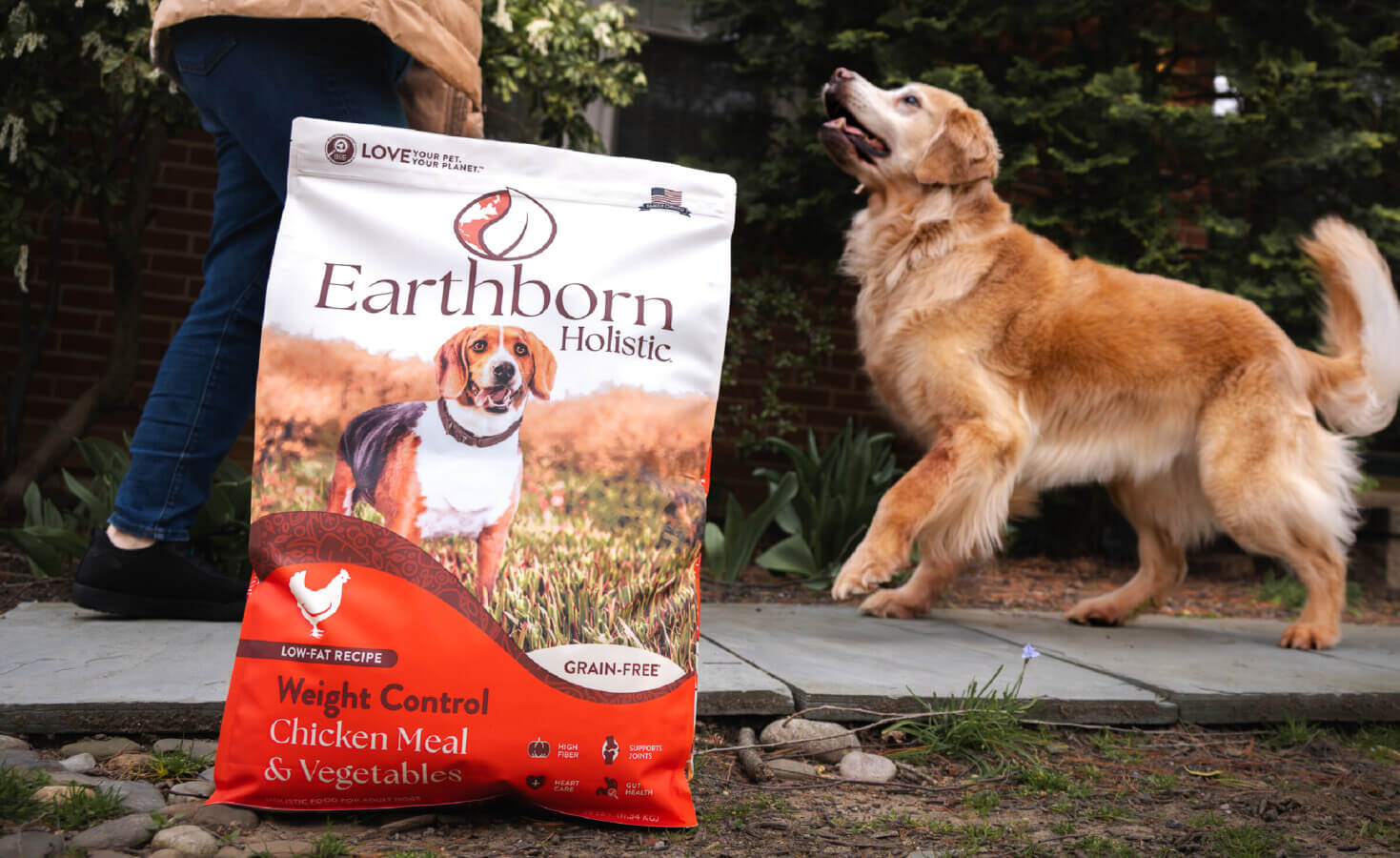
Should Dogs Eat Grain Free Food?
Grain-free dog food recipes are super popular. When it comes to the question of “should dogs eat grain-free food?”, it’s entirely up to the pet parent on what they’d rather feed their dog. While some pet parents prefer to feed a diet filled with healthy whole grains, some dogs have sensitive stomachs or allergies to grains or gluten, making a grain-free diet for dogs a better option for them.
You might be wondering exactly what is considered a grain in dog food. Whole grains and ancient grains are umbrella terms for a variety of ingredients:
- Whole wheat
- Brown rice
- Barley
- Oats
- Millet
- Quinoa
- Sorghum
- Rye
- Corn
While all of these are options that are commonly found in dog food, some are better than others. For example, you’ll never find corn, wheat, or soy on the ingredients list of any of our Earthborn Holistic, Venture, or Unrefined recipes. Instead, you’ll find things like oatmeal, brown rice, and quinoa added to our whole grain recipes.
That being said, we still have a range of grain-free recipes as well for pet parents who prefer them. Instead of whole grains, these recipes are fortified with extra superfoods like sweet potato and pumpkin but still feature healthy animal proteins as the first ingredient.
Why Grain-Free Dog Food?
Why feed grain-free dog food? While grain-free dog food is growing in popularity, grain-free recipes serve a functional purpose, too. Food allergies in dogs are becoming a much more common occurrence as dogs develop allergies to more and more ingredients, with grains being one of them. Grain and gluten allergies in dogs are one reason why grain-free dog food and treat are important options to have. So if you’re wondering, “is grain-free bad for dogs,” the answer is no.
Curious About Dog Food For Weight Loss? Here Are The Signs Your Dog Is Overweight?
When it comes to how to tell if your dog is overweight, there are several things you can look for. More obvious signs you may have an overweight dog include changes in their physical appearance and having a harder time getting around, whereas less obvious signs your dog is overweight can include things like snoring, or your dog may even be one of the breeds prone to obesity. You can also get a rough idea of if your dog may be overweight by looking at a body condition score chart.
Either way, if you think your dog is overweight, it’s important to schedule a vet visit to ask a veterinarian what the best course of action is and to figure out a weight loss plan for your dog if they are overweight. You may also consider switching your pup’s food to a dog food for weight loss such as our Weight Control recipe, our best dog food for weight management and weight loss.
What Are Grains in Dog Food and Do They Add Unnecessary Calories?
When it comes to weight loss, weight management, and meeting your dog’s weight loss goals, the number of calories your dog consumes on a daily basis is super important. When it comes to grains in dog food, they don’t tend to make a huge difference in terms of caloric content, as there are very effective whole grain weight control dog foods. According to K9 of Mine, fats contain more calories per weight than proteins or carbs, which is why many weight control dog foods have both increased protein levels and decreased fat levels. You can find both the fat and protein levels of a recipe on the label’s guaranteed analysis.
That being said, grain free weight control dog foods are plenty common too. While grains can provide great sources of fiber to help your dog feel full after a meal, they can also add calories. This is why it’s important to weigh your options when choosing a food for your overweight dog.
Are Grains Good for Dogs?
The question of “are grains good for dogs?” is dependent upon your dogs needs. While grain free diets for weight loss do exist, high-quality whole grain formulas sometimes work better for weight loss since whole grains like brown rice and oatmeal are complex carbohydrates that will leave your dog fuller for longer instead of filler foods that will have your dog hungry again not long after eating. However, it’s important to consider if the added calories from grains will work best for your own dog’s weight loss efforts. If not, a grain-free dog food like our Weight Control recipe is preferred and will absolutely still help your dog lose weight.
Is Wheat Good for Dogs?
Wheat is a very common ingredient in dog food, but wheat in dog food also very controversial. When it comes to “is wheat good for dogs?“, an article by PetMD puts it best:
“Corn, wheat, soy, rice and barley are not bad or harmful to dogs and cats. These plant sources are simply not good choices (we do get to choose what we feed our pets, don’t we?) for the foundation of a diet to optimally nourish animals what are, have been, and for the foreseeable future will be meat eaters.”
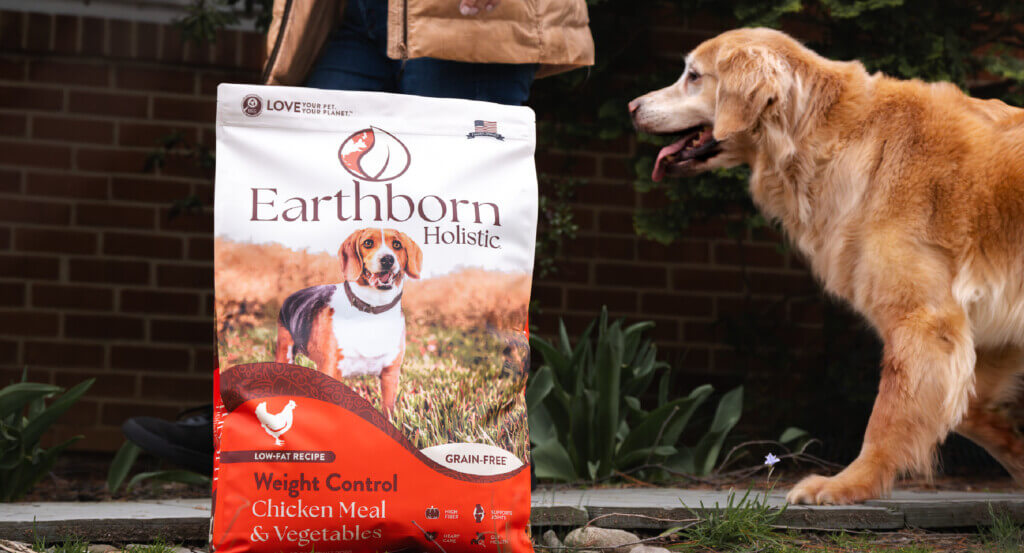
Does the Best Dog Food for Weight Loss Include Whole Grains?
When mixed with the right levels of protein, fat, and nutrients, whole grains can absolutely help with weight loss. As mentioned earlier, easily digestible grains like brown rice and oatmeal are considered complex carbohydrates. Complex carbohydrates aren’t fattening and often include more fiber–another thing that helps with weight loss–and are great ways to help your dog feel fuller without the extra calories. The best dog food for weight loss with grain will be complete and balanced while still having a good ratio of proteins, fats, and complex carbs. A low-fat, high-fiber dog food is key.
According to AKC, “Fiber is an excellent nutrient for dogs on a weight management program. Obesity is the leading cause of many illnesses in dogs, but owners are reluctant to decrease the amount of food they feed their pets. Fiber allows dogs to feel full while consuming very few calories, so switching to a high-fiber dog food is often a good choice for those trying to take weight of their dogs. You might find that the majority of weight-control dog foods commercially available are high in fiber.”
As with any weight loss dog food, you’ll want to make sure that the recipe is not only low fat but has the right kind of fats. Omega 6 and Omega 3 fatty acids are the “good fats” that you’ll want to look for when searching for the best dog food for weight loss. In our Weight Control recipe, these are ingredients like Pacific Whiting Meal and flaxseed but can be in other recipes as sunflower oil, salmon, herring, and chia seeds.
Another benefit of feeding your dog a whole grain weight control recipe is that the nutrients in grains help with your dog’s energy levels. This comes in particularly handy when you’re increasing your dog’s daily exercise as well in order to help them lose weight. Your dog will need more energy if they’re going on a daily walk that they’re not used to, so a whole grain dog food for weight loss will help in this sense as well.
Does Grain-Free Dog Food Help With Allergies?
If you’re looking for the best dog food for dogs with allergies, odds are the recipes you’re looking into are limited ingredient diets. Limited ingredient diets are great options for dog food for dogs with allergies or dog food for skin allergies and feature fewer ingredients that are known to be common allergens for dogs like chicken. While many limited ingredient diets are grain-free, it’s not accurate to say that a grain-free diet will reduce your dog’s allergies, especially if grains aren’t the culprit.
Working with your vet to determine what exactly your dog is allergic to and finding a food that doesn’t contain that specific ingredient is the best course of action, as they will be able to help you find a food that works best with your dog’s immune system.
Benefits of Whole Grain Dog Food
There’s a long list when it comes to the benefits of whole grains. For starters, whole grains are great sources of fiber.
According to Dog Food Advisor, “Adding fiber to any dog food “dilutes” its caloric content. So, there are fewer calories per serving. And that significantly aids in weight loss. As fiber absorbs water, it expands… causing a dog to stop eating sooner. That’s because (in dog’s) a full stomach signals ‘satiety’… or hunger satisfaction. So, dogs feel fuller… and consume less energy… fewer calories… per meal. A recent study showed that dogs fed a high fiber diet lost more than five times the fat mass of dogs fed a low fiber diet. As a matter of fact, trying to bring about canine weight loss without using dietary fiber makes the whole process needlessly more difficult.”
Fiber in dog food also helps to lower cholesterol, another thing that’s really important to watch out for if your dog is overweight. A low-fat, high-fiber dog food will help your dog feel full for a longer period of time during their weight loss journey.
Not only are grains a great source of fiber, but they’re a great natural source of protein and essential nutrients as well. When your goal is to help your dog lose weight, you typically want to find dog food with higher protein levels. While a lot of the protein in your dog’s food should come from the animal protein, grains are definitely an added bonus protein and will help contribute to the levels of fiber.
Choosing the Best Dog Food for Weight Loss: Understanding Whole vs. Refined Grains
One thing to look for in dog food is whole grains–not refined grains.
According to The Nutrition Source by Harvard, “Whole grains offer a ‘complete package’ of health benefits, unlike refined grains, which are stripped of valuable nutrients in the refining process.
“All whole grain kernels contain three parts: the bran, germ, and endosperm. Each section houses health-promoting nutrients. The bran is the fiber-rich outer layer that supplies B vitamins, iron, copper, zinc, magnesium, antioxidants, and phytochemicals. Phytochemicals are natural chemical compounds in plants that have been researched for their role in disease prevention. The germ is the core of the seed where growth occurs; it is rich in healthy fats, vitamin E, B vitamins, phytochemicals, and antioxidants. The endosperm is the interior layer that holds carbohydrates, protein, and small amounts of some B vitamins and minerals.”
They go on to say that bran and fiber slow the breakdown of starch into glucose, helping to maintain a steady blood sugar and fiber levels, which we know help lower cholesterol, another important aspect of weight loss. When you choose a weight loss dog food that has whole grains, your dog is getting the most nutrients possible out of the ingredients in their food and is also getting the added fiber and benefits of fiber in their diet as well. Whole grains can be a variety of ingredients, ranging from brown rice to barley to quinoa to oats. Refined grains, on the other hand, are things like white flour and white rice.
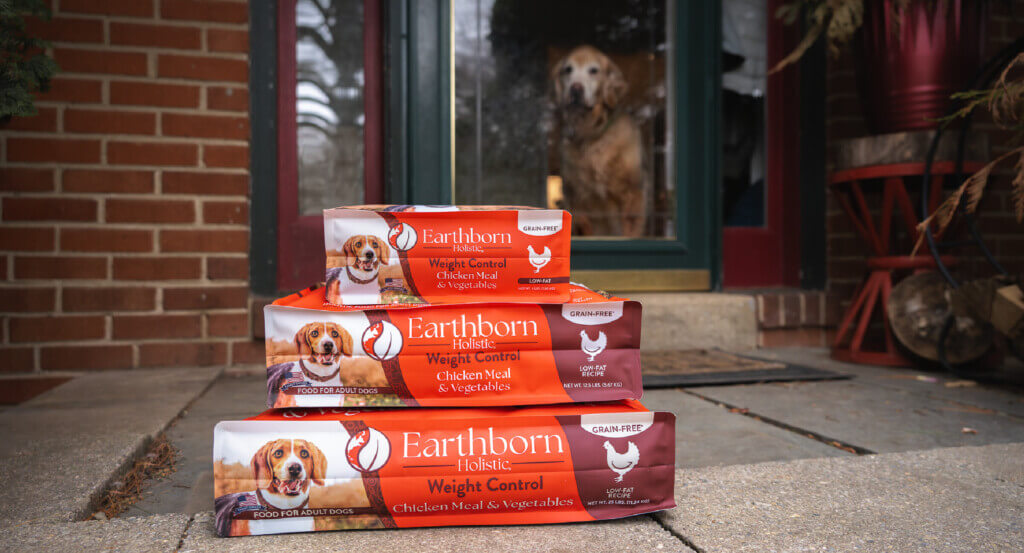
Our Weight Control Dog Food
If you’re looking for a holistic weight management dog food recipe, our grain-free Weight Control recipe is made with high-quality turkey protein as the first ingredient. A low-fat dog food recipe, this dog food is also packed with nutritious superfoods like blueberries, cranberries, apples and carrots. This weight control dog food without chicken helps keep your dog healthy and fit by reducing fat without reducing the unnecessary nutrients for optimum health.
When looking for a weight control dog food, low-calorie recipes should be your first priority. Our Weight Control recipe comes in at just 305 kcal/cup, making it a great low-fat weight control dog food option. Compared to some of our other recipes which have upwards of almost 400 kcal/cup (which can be a perfectly normal level for healthy dogs), this recipe is a great low-calorie option to help your dog lose weight.
In addition to fiber, Weight Control is also fortified with essential nutrients that help your dog along their weight loss journey. Glucosamine and chondroitin sulfate are two super important nutrients that you should look for in weight control dog food, and our recipe ticks this box! Glucosamine and chondroitin are important additions to weight control dog food because they’re amino acids that assist with joint health.
When your dog is overweight, it puts extra stress on their joints. Add this to other factors like aging or other health issues and you could have even bigger health issues on your hands if you’re not careful. While glucosamine focuses on pain relief, chondroitin has more anti-inflammatory properties and both can help with joint issues that can spur over time. Glucosamine and chondroitin help strengthen your dog’s joints, so the best weight loss dog food will include both to help combat joint-related health issues like Osteoarthritis and arthritis.
Another thing you’ll want to look for in a weight management dog food is a lean protein source like turkey. Some proteins are often high in saturated fats and turkey specifically is a low-calorie protein, making it great for weight loss. Our Weight Control recipe features high-quality turkey meal as the first ingredient, so you’ll feel great about that adding to your dog’s weight loss journey.
Lastly, our Weight Control recipe is enriched with Taurine for heart health. According to VCA Hospitals, obese dogs develop an increased risk for heart disease (among other things), so supporting heart health with taurine is essential when it comes to weight control dog food. All of our Earthborn recipes are enriched with taurine so this isn’t anything new, but it’s an important thing to look for when you’re searching for a weight loss dog food nonetheless.
Speaking of what our Weight Control recipe includes, you’ll be happy to find its entire ingredients list is just as good:
Chicken Meal (Natural Source of Glucosamine and Chondroitin), Peas, Sweet Potato, Tapioca, Pea Starch, Pea Fiber, Dried Yeast, Pumpkin, Dried Egg, Flaxseed, Canola Oil, Natural Flavor, Salmon Meal, Alaska Pollock Meal, Whiting Meal, Apples, Blueberries, Carrots, Cranberries, Spinach, Dried Chicory Root (A Source of Inulin, a Prebiotic), Choline (Choline Chloride), Salt, Potassium Chloride, Taurine, L-Carnitine, Vitamins [Vitamin E (α-Tocopherol Acetate), Vitamin C (L-Ascorbyl-2-Polyphosphate), Vitamin B3 (Niacin), Vitamin B5 (Calcium Pantothenate), Vitamin B1 (Thiamine Mononitrate), Vitamin B2 (Riboflavin), Vitamin A (Vitamin A Acetate), Vitamin B12 Supplement, Vitamin B6 (Pyridoxine Hydrochloride), Vitamin D3 (Cholecalciferol), Vitamin B7 (Biotin), Vitamin B9 (Folic Acid)], Minerals [Zinc Sulfate, Ferrous Sulfate, Manganese Sulfate, Copper Sulfate, Zinc Proteinate, Manganese Proteinate, Copper Proteinate, Calcium Iodate, Sodium Selenite], Yucca Schidigera Extract, Rosemary Extract, Probiotics [Dried Enterococcus Faecium Fermentation Product, Dried Lactobacillus Casei Fermentation Product, Dried Lactobacillus Acidophilus Fermentation Product].
If you’re on the hunt for the best weight control dog food, our Weight Control recipe is a great high-quality option to help your dog lose a few extra pounds.
Why Pea-Free?
The consumer demand for pea-free dog food is continually increasing, which begs the question—can dogs have peas? And are peas good for dogs? The answer is yes, dogs can have peas and peas actually have several benefits to dog food including added protein and several vitamins and minerals. However, some pet parents would just rather have no peas in dog food so we have recipes without peas to serve as an option to those dogs as well.
Interested in Weight Loss Dog Food Recipes? Here’s How to Change Your Dog’s Diet Safely
If you’ve found a weight loss dog food recipe and are ready to make the switch for your dog, it’s important to learn how to switch dog food gradually, as changing dog food too quickly can cause digestive issues and stomach upset if your dog is sensitive to sudden food changes. Instead, we recommend the following feeding schedule when switching dog food–weight management or otherwise:
- Days 1 & 2 – 25% new food, 75% old food
- Days 1 & 2 – 25% new food, 75% old food
- Days 3 & 4 – 50% new food, 50% old food
- Days 5 & 6 – 75% new food, 25% old food
- Day 7 – 100% new food
That being said, sometimes it could take longer to switch if your dog has a food sensitivity, so be sure to ask a vet if you have any concerns.
Healthy Grain Free Treat Recipes to Help Your Dog Lose Weight
Have you been looking for low-calorie, healthy treats for dogs? We all deserve to be “treated” every now and then after eating healthy, so why not pick a treat for your dog that is equally healthy and delicious! Our EarthBites healthy soft dog treats are the perfect choice! These grain free dog treat recipes are only 5-6 kcal per treat and are packed with fruits & vegetables for dogs such as blueberries and carrots. These soft treats can be broken into smaller pieces making them great for training or senior dogs. If your dog has been struggling to lose weight, EarthBites are a great option for weight control.
Another great healthy treat option is our crunchy oven-baked biscuits. These healthy dog treat recipes are only 9-10 kcal per treat and follow the ten percent rule, which means that treats should not make up more than 10% of your dog’s diet. Depending on how much you feed in your dog’s overall diet, you will have to factor in the amount of calories per treat as well. Our biscuits are also packed with premium proteins such as bison, chicken, lamb, and whitefish. Each bite is filled with vegetables and fruits for dogs like apples, cranberries, and spinach. The hard, crunchy texture helps keep your dog’s teeth clean. Can you believe that all of those great benefits are filled into a low calorie treat?
If you’re looking to keep your dog’s coat shiny and skin healthy our EarthBites Chewy with Salmon Protein treats are a nutrient-rich source of Omega-3 fatty acids to keep your dog’s coat shiny and skin healthy.
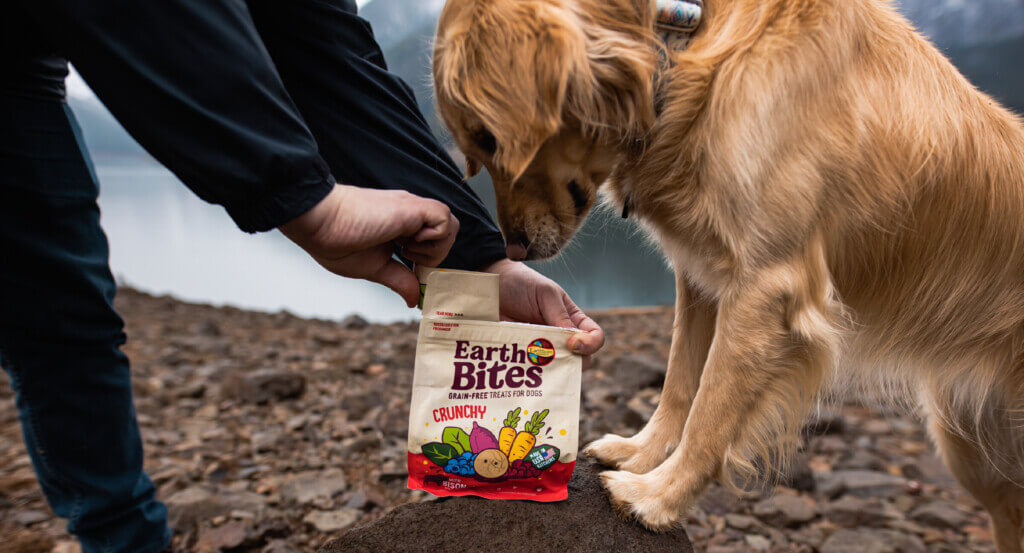
More Ways to Help Your Dog Lose Weight With the Help of Earthborn’s Homemade Grain Free Dog Food
Aside from a healthy diet, there are other ways to help your dog if they’re needing to lose a few pounds.
While a weight control dog food will do wonders, portion control is the real trick to helping your dog lose weight. Overfeeding and lack of scheduled feeding will only put your dog at more of a disadvantage, so make sure once you figure out how much your dog should eat and how many times a day they should eat you stick to that. And don’t forget to give your dog access to fresh water to keeping them hydrated, which is super important if you’re increasing their daily exercise, as it will also help keep them full. If you’d like to make dinner time more exciting for your pup, you can also experiment with things like puzzle feeders to stimulate your dog’s mind while they eat as well.
When it comes to weight loss, your dog’s diet is only one piece of the puzzle. On top of a healthy dog food, daily exercise or a dog workout will be a huge help to your dog’s weight loss journey. The good news is that getting your dog moving is just as easy as a walk around the block! Whether it’s taking a stroll through your neighborhood, taking a trip to the local dog park, going on a hike, or enrolling in a dog sport like dock diving or scent work, there are all sorts of ways to help your dog (and maybe even yourself!) burn some extra calories.
If you’ve determined your dog is overweight and are looking for weight loss options, the best thing you can do is to seek veterinary help. Diet and exercise are super important, but in the end, your vet knows your dog best and will be able to help you come up with a weight loss plan that fits your and your dog’s lifestyle. They’ll be able to help you determine how many calories your dog should be eating in order to achieve a healthy weight loss rate, help you find a weight management dog food, and help you develop an exercise routine that will help your dog become more and more healthy. Regular vet visits will also help you monitor progress so you’ll be able to tell if your efforts are actually working or if you need to adjust your routine.
In the end, dog foods for weight loss come with a variety of ingredients and benefits. Learning the differences between grain-free and whole grain recipes and deciding which will work best for your pup is a great start, but there’s so much more to take into consideration when it comes to weight control dog food. Whichever you choose, make sure you’re looking for a low-fat, low-calorie, high protein dog food that will keep your dog healthy. Make sure you know how to read a pet food label so you can decipher the differences between different brands and recipes, and don’t forget to check with your vet to determine the best course of action for your dog’s weight loss journey so you can be sure you’re giving your dog the best nutrition possible.
Have questions about our Weight Control recipe or any of our other recipes? Send us a message!


